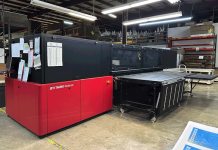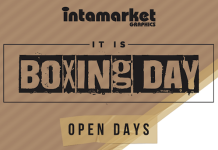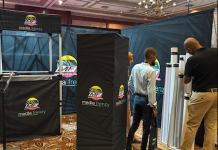Thunderbolt Solutions’ Digital Inkjet Roadshow presented the extensive benefits of digital printing to the market, allowing visitors from printing companies the ability to gain firsthand insight into Thunderbolt’s suite of digital inkjet printing solutions.
The roadshow took place in Johannesburg on 9 and 10 May at the Wanderers Club, Durban on 11 May at Mount Edgecombe Country Club and Cape Town on 12 and 13 May at King David Mowbray Golf Club.
International speakers addressed industry trends:
Edi Venturin: Regional Business Manager, Agfa
Venturin outlined inkjet in a wide format context, and said that inkjet machines are capable of running at lower costs. Agfa offer complete inkjet printing systems, saving costs with innovative calculation. ‘We have machines, software and inks – all perfectly matched,’ said Venturin.
The company’s thin ink layer technology ensures less ink wastage than competitors, with some being 80% less. Their aim is to achieve the same quality with different machines of different sizes and speeds. Some options are also field upgradable. The company do use other companies’ printheads, but have their own ink and software. ‘The synergy between inks, hardware, software and services make our inkjet solutions unique.’
‘For inkjet, in wide format we are seeing growth in corrugated packaging. In high-end, high-speed machines, there is also a move toward industrial applications. Inkjet opens up new opportunities for print that were not possible before, such as bespoke short runs and specialties. These applications require lower costs, lower stock and faster access to market, in contrast to screen printing and offset, which require much more time.’
Gareth Wheeldon: Sales Executive, Komori UK

Wheeldon said that inkjet is already transforming the way that a number of sectors of industry serve their customers, and that they are having to reassess their production capabilities: ‘There is enthusiasm, especially with book printers; they don’t want large inventories. There is a strong desire for short-run packaging and there’s also a wider colour gamut with inkjet inks than with offset four colour, which meets all the requirements for packaging.’
He also said that inkjet is perfectly suited for fast turnaround times, and added that inkjet is not about to replace offset, but that the two just happen to complement one another, and that working in parallel, they enable a well managed company to meet the demands of customers.
Wheeldon outlined Komori’s extensive portfolio of machines and consumables, with a strong emphasis on the company’s flagship Impremia IS29 digital inkjet printing system, which features a wide range of applications such as book printing and short-run packaging. A wide substrate choice, low energy consumption and compact design are some of the machine’s key aspects.
He added that LED curing allows for excellent adhesion, hence the ability to print on paper, board, plastic and more. Folders, slitters and coating units can be added. Seamless workflow for batch processes, wider colour gamuts, calculation of ink consumption and automatic software updates were also taken into consideration upon the machine’s development.
Wheeldon listed benefits such as quality, substrate choice, instant curing and low maintenance, as well as less need for sensitive parts and components within the machines that are susceptible to wear and tear, all of which he said are reasons to choose Komori.
Bui Burke: Senior VP Sales, Screen Europe

Burke mentioned that inkjet trends are much the same in Africa as they are globally, although Africa lags slightly behind. ‘The trend is toward inkjet, be it with labels, commercial print or packaging.’ He also said inkjet is replacing toner and conventional presses, as well as flexo presses. ‘Inkjet allows users to order what they need, when they need it. It is easy to use.’
Burke outlined Screen’s high speed continuous devices and constant investment in new equipment, with a strong emphasis on quality, speed, reliability, wider applications, lower running costs and the ability to print on a wider range of substrates. The company’s SC Ink (coated stock ink) is unique, as well their SC + inks, which feature high densities, so less ink is needed, producing higher vibrancy and more scuff resistance.
Burke said while Screen don’t manufacture ink and printheads, they have the know-how of the best printhead and ink combination, where as little ink as possible is used. He added that Screen are committed to inkjet, an area in which they want to move forward. Their innovative NIR drying equipment (drying ink before it hits the paper) and power management features in their machine portfolio also make them unique.
Deon Wepener: Expert Production Print Solutions, Kyocera Europe

Wepener said that while Kyocera’s specialty is inkjet heads that are well known in the industry, they decided to take these printheads and place them into their own platform, out of which the flagship cut-sheet inkjet device, the TASKalfa Pro 150000C, was borne. He added that Screen, for example, uses some of their printheads.
The TASKalfa Pro 150000C ensures a lower power consumption, and is simple and straightforward, with fewer components. The software also calculates the right amount of ink. If a punch hole is detected, the printheads won’t apply ink – an ideal savings aspect. Paper companies like Mondi have optimised their products for such inkjet devices, which equates to massive cost savings. Different ink drop sizes (or multi-drop size technology) allow for smoother prints.
Some of the trends in inkjet technology, as far as the company is concerned, include educational books and training manuals (mostly Africa), although in Europe transactional applications are a good fit, as well as different colour reading books, which are specifically well-suited for the TASKalfa. ‘Inkjet is constantly growing, so it is perfect for where something new is needed,’ said Wepener.
Gavin van Rensburg, Regional Manager, Western Province, Thunderbolt Solutions, said, ‘The drivers in inkjet are much lower maintenance compared to previous xerography based technology.’ Another advantage of inkjet, he said, is consistency of operations from start to finish, as well as the ability to print on different substrates. He said that inkjet is on the increase, adding that South Africa is lagging behind due to reasons such as Covid-19, but that prices are coming down and the range of substrates is increasing all the time.
THUNDERBOLT SOLUTIONS
+27 11 657 7000
www.thunderbolt.co.za















